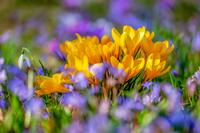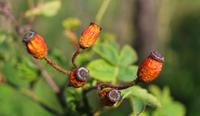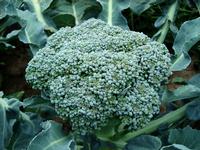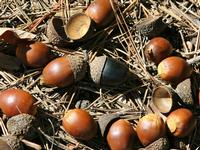December

Yuletide camellias (Sasanqua Camellias)
These gorgeous camellias offer red blooms with yellow centers and are in bloom from November through January. Perfect timing for the holidays! They produce lots of blooms, hold up well with more sun and are for the most part resistant to blossom blight.
Early-Flowering Azaleas
There are long-blooming/early varieties of azaleas that will provide you with amazing color during the fall through spring (assumes no frost). Consider planting some of these azaleas along with camellias on a north-facing side of your house.

Crocus and hyacinth bulbs can be planted now, as well as tulips that have been refrigerated for six weeks. Crocus bulbs can be planted in low containers to better show off their blooms. They will do best where you can keep the soil cool.
Tulips planted in containers should be kept in a cool place and covered with a box until they have develop leaves 2 – 3 inches tall. Don’t forget to water them! This will help them develop a good root system. Uncovered, the container can be placed in a shady area.
Tulips may also be planted in the ground. Make sure you plant them on the north side of the house or trees. Another suggestion is to plant them in morning sun with other foliage to shade them. Feed with an organic liquid fertilizer at the time of planting and then again when the leaves have sprouted.
Hyacinths will grow nicely in either the ground or in containers.
After pre-chilling these bulbs, dig holes 5” deep and 6” apart from each other. Mix some bone meal into the soil beneath where each bulb will be placed, plant the bulb and cover with soil. Water thoroughly.
Once Hyacinths in containers have started growing, put them outdoors or in a sunny window. Be sure to turn the pots in the window daily to help the stems grow straight.
Amaryllis plants are a Holiday favorite and may be purchased as single bulbs or already planted in a container.

Don’t feed or deadhead your roses this month. Now is the time to encourage your roses toward dormancy. Major pruning is usually done in January.

Leafy vegetables and brassicas grow well now. If you already have some mature plants, you may want to add more to extend your harvest. At this time of year, it is best to use nursery starts rather than seeds. For more choices, check with A Year of Growing Vegetables
New asparagus crowns can be planted now through February. Planting asparagus

The garden is a treasure trove of possibilities for holiday decorations. Pyracantha berries alternated with popcorn make attractive garlands. Oranges, lemons, or apples sprinkled with cinnamon or cardamom and stuck with whole cloves are delightfully fragrant pomander balls. Rose hips add bright red and orange colors to green wreaths. Herbs can trim yule logs, flavor jelly, give fragrance to clusters of twigs or wreaths and perfume the air in stovetop potpourris. Vines from grapes, honeysuckle, wisteria, willow, or ivy will bend into many usable shapes. Eucalyptus pods, pine cones, acorns, and magnolia leaf clusters provide many shades of brown. Bufford's holly, which grows better here than the traditional variety, gives us pointy-leafed green with red berries. And don't forget the mistletoe.
General maintenance tasks
Clean up all garden debris. Leaving it in the garden provides safe havens for overwintering pests. Compost debris, but be sure to toss any diseased material -- don't add it to the compost pile. Periodically rough up soil surfaces to bring any overwintering insects and their egg cases to the surface where they'll die of exposure.

